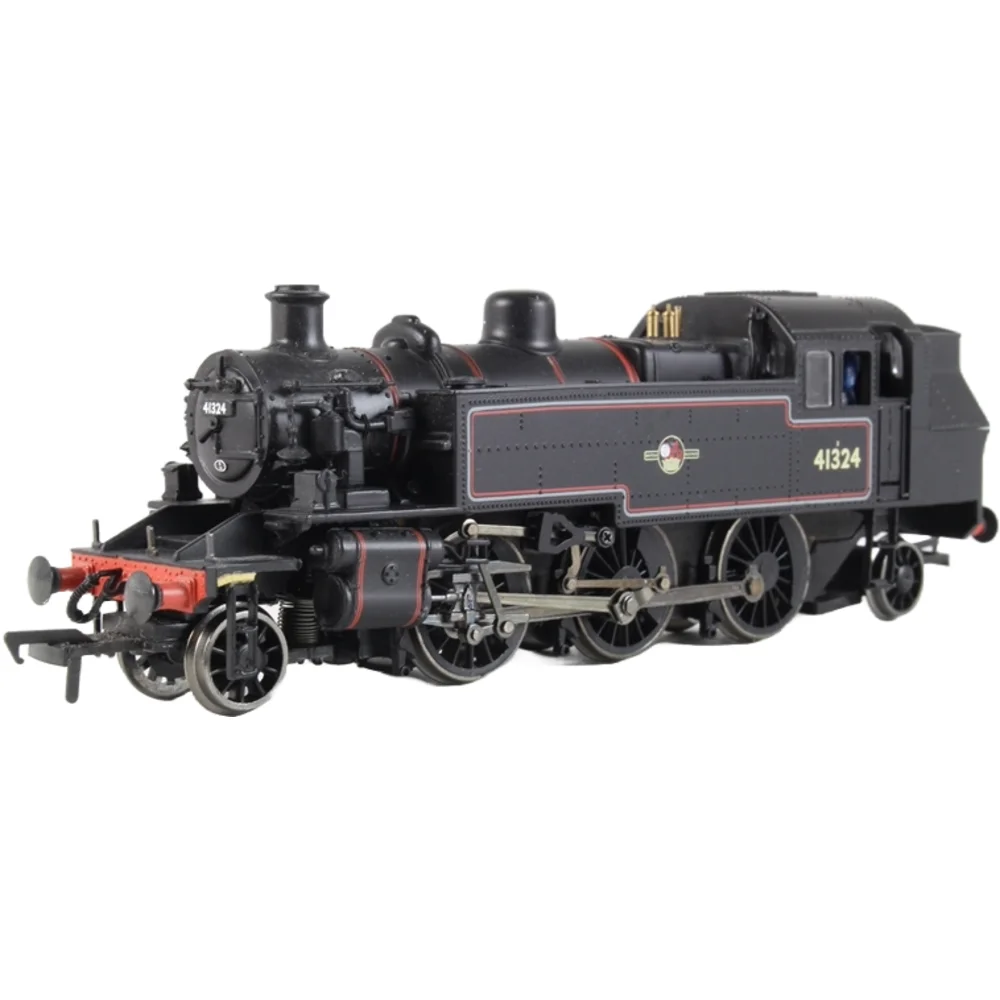Bachmann 31-450D
London, Midland & Scottish Railway Ivatt Class 2 2-6-2T 41324 British Railways Lined Black with Early Emblem
Tooling
The LMS Ivatt Class 2MT 2-6-2T was a light mixed-traffic tank locomotive designed by H.G. Ivatt and introduced in 1946 to replace ageing tank engines. Bachmann Branchline launched its model of the 2MT 2-6-2T in 1995 as part of its early British-outline range, marking one of the first fully new toolings developed by Bachmann UK following its acquisition of Mainline and Replica Railways assets. The model aimed to capture the compact yet purposeful nature of the prototype, which served across LMS and later BR regions until its withdrawal in the 1960s.
Tooling Features
- Scale: OO Gauge (1:76)
- Construction: Plastic bodyshell with die-cast chassis
- Detailing: Factory-fitted handrails, pipework, turned brass safety valves and whistle, glazed cab windows, and separately fitted bufferbeam details
- Couplings: Tension lock couplings with NEM pockets (on later revisions)
Mechanical & Electrical Specification
- Chassis: Split chassis design (typical of 1990s Bachmann models)
- Motor: Coreless motor located in the locomotive body
- Drive: Loco-driven wheels (2 powered axles)
- Minimum Radius: Compatible with Radius 2 curves
- Weighting: Internal chassis weights to aid traction
- Electrical Pickup: 2-rail DC, pickups on driving wheels only
- Lighting: No factory lighting fitted
DCC Capability
The original 1995 tooling is DCC incompatible due to its split chassis design. Retrofitting a decoder requires significant modification, including chassis milling and rewiring. Later versions of the model were updated with DCC-ready sockets and improved PCB layouts, but early models remain challenging for digital conversion.
Liveries Produced
- LMS Black (1923–1947)
- BR Black with British Railways Lettering (1948–1951)
- BR Plain Black (1948–1980)
- BR Black with Early Emblem (1949–1957)
- BR Black with Late Crest (1957–1968)
- Keighley and Worth Valley Railway Maroon (Preservation Era)
Reviews & Commentary
Early reviews praised the model’s detailing and accurate proportions, especially the fine handrails and cab fittings. However, the split chassis design drew criticism for its complexity and limitations in DCC conversion. The motor performance was considered adequate but not exceptional, with some users reporting noise and inconsistent running. Later revisions improved reliability and added DCC readiness, making the model more appealing to modern modellers.
Media & Social Media
The Ivatt 2MT 2-6-2T remains a popular subject in online forums and YouTube reviews, often featured in layout running sessions and weathering tutorials. Social media commentary highlights its suitability for branch line operations and its nostalgic appeal for modellers recreating mid-century British Railways scenes. The KWVR maroon version is especially celebrated among preservation enthusiasts.
Additional Notes
Several limited editions and retailer exclusives have been produced over the years, including push-pull fitted variants and weathered finishes. Replacement parts such as motors, valve gear, and bodyshells are available through Bachmann’s spares service, supporting long-term maintenance and customisation.
Class & Prototype
- Class: London, Midland & Scottish Railway Ivatt Class 2 2-6-2T
- Traction: Steam
- Built: 1946-1952
- Total Built: 130
- Running Number: 41324
Operator & Livery
- Operator: British Railways
- Livery: Lined Black with Early Emblem
- Era: 4 - British Railways Early Emblem
British Railways transformed Britain's fragmented rail network into a unified national system following nationalisation on 1st January 1948. Created from the "Big Four" companies under the Transport Act 1947, BR operated most of Great Britain's railways until rebranding as British Rail in 1965, managing over 20,000 route miles and inheriting nearly 20,000 locomotives of diverse designs.
The organisation pioneered standardisation through its revolutionary BR Standard locomotive programme (1951-1960), producing 999 advanced steam engines under Robert Riddles' direction. These included the versatile Britannia Pacifics, mighty 9F freight engines, and mixed-traffic classes that incorporated the best features from all predecessor companies. The 1955 Modernisation Plan accelerated diesel and electric traction development, creating fascinating mixed-traction operations.
Notable achievements included establishing unified locomotive classification systems, introducing distinctive corporate liveries, and managing the complex transition from steam to modern traction. BR's six regional structure preserved operational diversity whilst enabling standardisation of practices, signalling, and rolling stock that had eluded private enterprise for over a century.
The BR era represents steam traction's final flowering alongside emerging diesel technology, creating unparalleled locomotive variety. Today, this heritage remains highly popular with railway enthusiasts through extensive preserved fleets, heritage railway operations, and comprehensive model ranges from manufacturers like Hornby, Bachmann, and Dapol, making BR subjects essential for authentic post-war British railway modelling across all scales.
British Railways' lined black livery was designated for mixed-traffic and secondary passenger locomotives from 1949, following pure LNWR style with black base colour and elaborate red, cream (off-white), and grey lining patterns. The lining specification comprised 5/8" grey, 1/8" cream, 1½" black, and ¼" red bands, with the layout consistent with LNWR practice including deep and shallow valances lined along bottom edges only, unlike green engines. The first lined black engines appeared in August 1948 when Hall 5954 appeared so painted, becoming one of the first to carry the "Lion and Wheel" emblem around the same time.
A wide range of engines was eligible for this livery, from powerful V2s and Counties down to tiny Southern Terriers, encompassing County, Hall, Grange, Manor, Saint, Prairie tanks, and numerous pre-grouping designs of varied shapes and sizes. This created many variations and interpretation problems due to the diverse locomotive types involved, with regional differences in splasher lining treatment—the Eastern Region used red-only splasher lining, whilst the Southern Region evolved from inset to edge lining styles. The emblem was positioned centrally on tender sides above the middle axle box, with the Western Region favouring larger sizes on tenders and bigger tank engines. An interesting period detail saw number plates routinely painted red from late 1949 to early 1952, adding colour contrast to the otherwise black scheme. This livery represented BR's commitment to standardising mixed-traffic operations whilst maintaining the decorative traditions that distinguished passenger-rated locomotives from plain freight engines.
